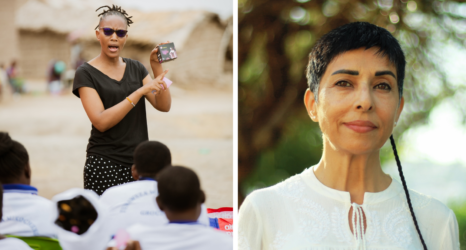By Catherine Powell, Gayle Tzemach Lemmon and Hannah Chartoff
At a White House press conference in March, U.S. President Barack Obama, standing beside Afghan President Ashraf Ghani, announced that he would delay the schedule for U.S. troop withdrawal from Afghanistan. Rather than bringing 4,300 troops back home by the end of this year—nearly half the force currently stationed in Afghanistan—troop levels will remain steady through 2015.
The extension had been requested by President Ghani to allow Afghanistan’s economy and civil society more time to grow and develop, let alone enabling the Afghan military to build up its capacity. According to public opinion polls, the extension is supported by nearly half of Afghans. And it’s especially good news for Afghan women and girls.
Since the 2001 fall of the Taliban, women and girls have made huge gains in Afghanistan—gains that could be lost if the security situation in the country should worsen with the withdrawal of U.S. troops. Roughly 900,000 Afghan boys were enrolled in public school in 2002 and virtually no girls. But currently, more than 3 million girls are enrolled in school, while young women comprise almost 20 percent of college students. Women’s literacy has increased to nearly 15 percent nationwide—compared to only 5 percent in 2002. Among girls 15 to 24, it’s twice as high. Plus, support for girls’ and young women’s equal access to education is high: A 2013 poll by the Asia Foundation found that more than 83 percent of Afghans agree that women should have equal access to education as men.
Afghan women have also stepped up their political participation. Women’s turnout for the first round of the most recent presidential election, in April 2014, was estimated at 36 percent—despite numerous death threats from the Taliban directed at potential voters. (The overall turnout of 58 percent was about the same as the last U.S. presidential election.) Despite killings and even more threats, the June runoff turnout rose to 38 percent.
Also, more women candidates than ever (around 300) ran for provincial council seats despite threats of violence. Three women ran for vice president, while each of the three leading presidential contenders (all men) declared their intention to support causes important to women. One of the leading candidates had a female running mate, and President Ghani’s wife, Rula, addressed crowds on the campaign trail. These are all major milestones for a country in which women’s involvement in politics has been historically minimal.
Yet despite the gains that have been made, serious gaps remain. In an ideal world, military power would never be needed to safeguard human rights. Without a basic level of safety and security from the Taliban insurgency, however, women and girls will not be able to fully participate in public life. Violence and intimidation by insurgents threaten their ability to leave their homes to attend school, seek work or participate in politics. Taliban insurgents have attacked girls’ schools, students and staff.Teachers and health-care workers prefer working in safe urban centers, leaving millions of women and girls illiterate and vulnerable in rural areas and districts where there is instability.
Education isn’t just significant for individual girls but for the entire society. Research shows that women who are able to receive a better education earn higher wages and will invest increased earnings in their families, therefore giving their children greater educational, health and economic advantages. A child whose mother can read is 50 percent more likely to survive past the age of 5, and each extra year of a mother’s schooling reduces the probability of an infant dying by 5 to 10 percent. As President Ghani noted in his speech to a joint session of the U.S. Congress, “Educating one…young girl will change the next five generation[s] of a family.”
Ghani has outlined a vision for Afghanistan’s future that, in addition to building stability, focuses on growing the country’s economy and making it a self-reliant, contributing member to the international community. He paints a picture in which Afghanistan is a crucial player in the Asian economy—a hub for regional transit that will create jobs and decrease national unemployment.
As many U.S. policymakers have noted, continued U.S. military presence is—for now—critical to maintaining the gains made by Afghan women. In fact, by the end of 2014, Obama had ended the U.S. combat mission in Afghanistan, and most of the remaining American troops form part of a support, training and advisory role. However, the U.S. is not simply contributing security support. It also invests in women’s programs and services through USAID and State Department programs, and working in partnership with the Afghan Ministry of Women’s Affairs. Advocates say this is a critical step for cementing existing gains and providing mechanisms to further women’s empowerment.
“Our staying there, our investment in women there, sends a message to the world that women’s rights, democracy and modernity can succeed in Afghanistan,” says Feminist Majority Foundation President (and publisher of Ms.) Eleanor Smeal, who has worked for nearly two decades to advance Afghan women’s rights. And Ghani seems to have gotten the message that Afghan women are worth empowering for their own sake, not just for that of the country.
“Everybody describes women as their sisters, daughters, mothers and wives,” he says. “But they are women first, and I want to engage with them as women.”
This article is excerpted from the Spring 2015 issue of Ms. Subscribe today to get a copy!
Photo of Michelle Obama with Rula Ghani via The White House





